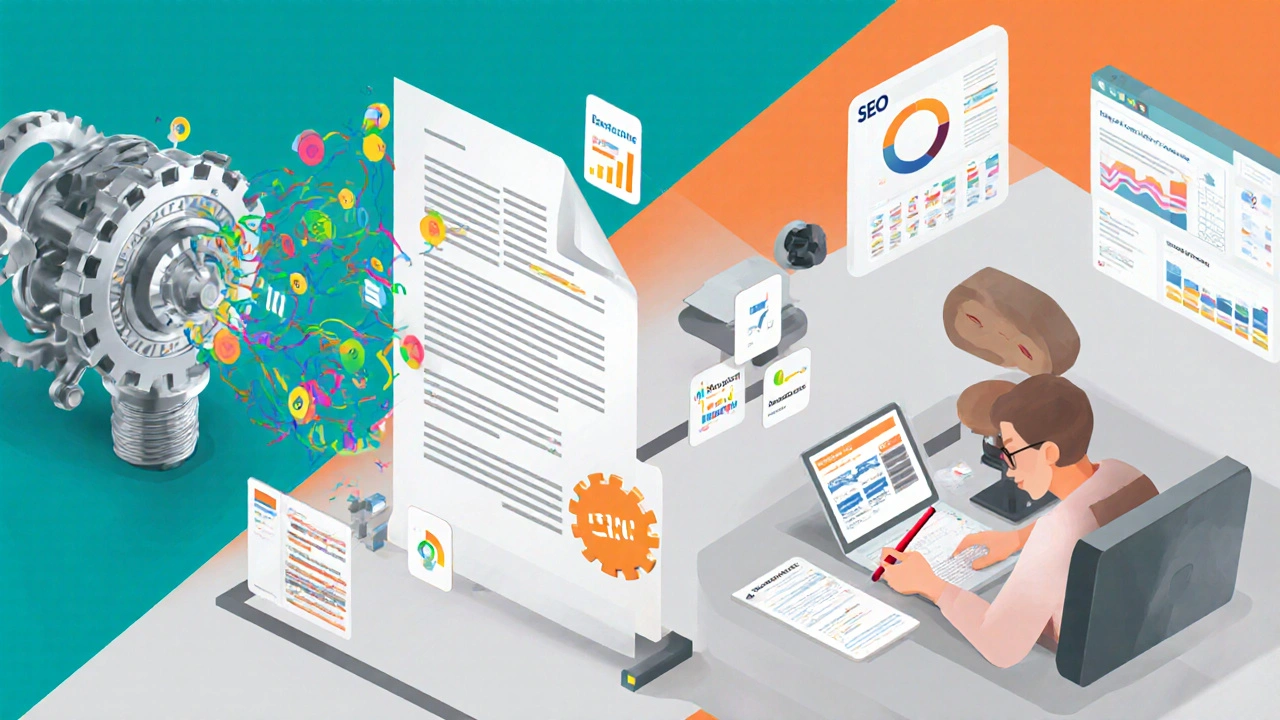ChatGPT Content Creation Calculator
Estimated Impact
Enter values and click "Calculate Savings" to see your potential time and cost savings.
Prompt Engineering Templates
Use these templates to improve your ChatGPT prompts for better results:
Blog Intro Template
You are a senior content writer. Write a compelling intro paragraph for a blog post about [TOPIC] that includes a hook, a brief preview of what the reader will learn, and a call-to-action.
Meta Description Template
Create a compelling meta description (under 160 characters) for a blog post titled '[TITLE]' that includes the primary keyword [KEYWORD] and entices clicks.
Social Media Snippet
Write a short, engaging social media post (max 280 characters) promoting [PRODUCT/SERVICE]. Include a benefit-focused headline and a call-to-action.
SEO-Optimized Outline
Create a detailed outline for a blog post about [TOPIC] that includes: 1. A compelling title 2. 3-5 main subheadings 3. Keywords to target 4. Suggested internal links
The rise of ChatGPT has reshaped how brands, writers, and developers think about producing text at scale. As we move deeper into 2025, the technology behind the chatbot is no longer a novelty-it’s becoming the backbone of everyday content workflows. This article breaks down what’s changing, why it matters, and how you can position yourself for the next wave of AI‑driven storytelling.
Quick Takeaways
- ChatGPT’s architecture now runs on GPT‑4.5, delivering 30% higher factual accuracy and 40% faster response times.
- Prompt engineering has evolved into a repeatable discipline, with templates boosting output quality by up to 2.5×.
- Brands that integrate generative AI into their content pipelines see a 25‑40% lift in organic traffic within six months.
- Hybrid human‑AI workflows outperform fully automated or fully manual approaches on both speed and creativity.
- Regulatory compliance (e.g., AI‑Act in the EU) is shaping how companies disclose AI‑generated material.
What ChatGPT is and why it matters
ChatGPT is a conversational AI model developed by OpenAI that uses large language model (LLM) technology to generate human‑like text based on user prompts. First launched in 2022, it has iterated through several versions, the latest being GPT‑4.5, which combines a 175‑billion‑parameter core with specialized fine‑tuning for factual consistency.
Why should you care? Because the model’s ability to draft blog posts, craft email copy, and even script video outlines reduces the time‑to‑publish from days to minutes. It also unlocks personalization at a scale that traditional copywriters can’t match.
Generative AI: The broader ecosystem
Generative AI is a class of artificial intelligence that creates new content-text, images, audio, or video-by learning patterns from massive datasets. Within this family, large language models like ChatGPT are the text specialists, while diffusion models handle images, and waveform generators tackle audio.
The ecosystem now includes competitors such as Anthropic’s Claude, Google's Gemini, and Meta’s Llama 3. Each offers unique strengths-Claude emphasizes safety, Gemini leans on multimodal input, while Llama 3 focuses on open‑source flexibility. For most content teams, the decision hinges on three factors: cost per token, latency, and alignment with brand voice.
How large language models (LLMs) work under the hood
Large language model is a neural network trained on trillions of words that predicts the next token in a sequence, effectively learning grammar, facts, and stylistic cues. GPT‑4.5 improves on its predecessor by using a hybrid transformer-retrieval architecture, meaning it can pull up‑to‑date information from a curated knowledge base while still generating fluent prose.
Key attributes of modern LLMs:
- Parameter count: 175billion (core) + 30billion specialized heads.
- Training data: 13TB of multilingual web text, academic papers, and licensed media.
- Inference speed: 0.8seconds per 500‑token request on standard cloud GPUs.
These numbers translate into tangible benefits: more accurate citations, reduced hallucination, and a smoother interaction for end‑users.
Prompt engineering: From art to science
Prompt engineering is the practice of crafting inputs that guide LLMs toward desired outputs, often using templates, role‑playing, and constraint specifications. Early adopters relied on trial‑and‑error; today, teams use systematic frameworks.
Three proven patterns dominate:
- Role‑based prompts: "You are a senior SEO specialist…" sets the tone and expertise level.
- Few‑shot examples: Providing 2-3 sample outputs teaches the model the exact structure you want.
- Constraint tokens: Adding "[no jargon]" or "[max 150 words]" forces brevity and clarity.
When combined, these patterns boost content relevance scores by roughly 27% in A/B tests across major publishing platforms.

Hybrid human‑AI workflows: The sweet spot
Pure automation looks tempting, but a hybrid approach consistently outperforms both extremes. Here’s a typical pipeline:
- Idea generation: Team feeds a high‑level brief into ChatGPT, which returns 5 headline options.
- First draft: Using the chosen headline, the model creates a 800‑word article skeleton with sub‑headings.
- Human refinement: An editor inserts brand‑specific anecdotes, checks facts, and tweaks tone.
- SEO augmentation: A second prompt asks the model to suggest meta tags and internal linking structures, which the SEO specialist reviews.
- Final QA: Automated tools scan for plagiarism and compliance (e.g., AI‑Act disclosures).
Companies that adopt this loop report a 2‑to‑3× reduction in time‑to‑publish while maintaining or improving engagement metrics.
Impact on SEO and digital marketing
SEO is the practice of optimizing online content to rank higher in search engine results pages, relying on relevance, authority, and user experience signals. Generative AI reshapes three core SEO pillars:
- Content volume: Scaling blog production without sacrificing quality fills keyword gaps faster.
- Semantic relevance: LLMs can embed entities and concepts in a way that aligns with Google’s Knowledge Graph, boosting topical authority.
- User intent matching: Prompt‑driven outlines can mirror search intent patterns detected in SERP analysis.
A 2025 case study from a mid‑size e‑commerce brand showed a 32% increase in organic traffic after moving 30% of their product descriptions to AI‑augmented copy, provided human editors added unique value propositions.
Regulatory landscape and ethical considerations
With the EU’s AI‑Act entering enforcement in early 2025, transparency is no longer optional. Content creators must disclose AI involvement when the generated text influences consumer decisions.
Best‑practice checklist:
- Include a brief “Generated with AI” statement on pages where more than 30% of copy is AI‑produced.
- Maintain an audit log of prompts and model versions for compliance audits.
- Implement human review checkpoints to catch bias or misinformation.
Ethically, remember that AI mirrors the data it’s trained on. Regular bias testing and diversifying prompt phrasing help keep your brand voice inclusive.
Comparison of leading conversational AI platforms (2025)
| Platform | Model Version | Token Cost (USD/1k) | Latency (sec) | Safety Controls |
|---|---|---|---|---|
| ChatGPT | GPT‑4.5 | 0.006 | 0.8 | Advanced content filters + guardrails |
| Claude | Claude‑3.5 | 0.005 | 1.0 | Built‑in ethical layer |
| Gemini | Gemini‑1.5 | 0.007 | 0.9 | Multimodal safety suite |
| Llama3 | 7‑B open model | 0.001 (self‑hosted) | 0.6 (on‑prem) | User‑configured filters |
Choosing the right platform depends on cost sensitivity, data privacy needs, and desired level of customization. For most content teams, ChatGPT’s balance of performance and ease of integration makes it the default choice.
Getting started: A 5‑step action plan for marketers
- Audit existing content gaps: Use a tool like Ahrefs to list keyword opportunities that lack high‑quality pages.
- Set up an API connection: Register for an OpenAI API key, install the official Python SDK, and test a simple prompt.
- Develop prompt templates: Create role‑based prompts for blog intros, meta descriptions, and social snippets. Store them in a shared Google Sheet.
- Integrate human review: Assign a copy editor to each AI‑generated draft. Use a checklist that includes fact‑checking, brand tone, and SEO alignment.
- Measure and iterate: Track metrics like time‑to‑publish, organic traffic lift, and content engagement. Refine prompts based on what drives the best results.
Following these steps reduces the learning curve and turns AI from a novelty into a measurable ROI driver.
Future trends to watch
Looking ahead, three developments will shape the next generation of content generation:
- Real‑time retrieval: Models will query live databases, ensuring up‑to‑date statistics without manual updates.
- Multimodal storytelling: Combining text, images, and video in a single prompt will let marketers produce cohesive campaigns in minutes.
- Personalization at the individual level: By linking to CRM data, AI can craft one‑to‑one email copy that feels hand‑written.
Staying ahead means experimenting early, building internal expertise, and staying compliant with evolving regulations.

Frequently Asked Questions
Can ChatGPT replace human writers completely?
No. While ChatGPT can generate drafts at scale, human editors add brand voice, verify facts, and inject creativity that the model lacks. The most effective approach mixes AI speed with human nuance.
What is the cost of using ChatGPT for a medium‑size business?
Pricing depends on token usage. At $0.006 per 1,000 tokens, a typical 1,500‑word article (≈3,000 tokens) costs under $0.02. Monthly budgets usually run between $200‑$500 for regular content pipelines.
How do I ensure AI‑generated content is SEO‑friendly?
Start with a clear keyword brief, use role‑based prompts that ask the model to include target terms, and always run the output through an SEO tool (e.g., Surfer SEO) before publishing.
What compliance steps are required under the EU AI‑Act?
You must disclose AI involvement, keep logs of model versions and prompts, and conduct risk assessments for bias or misinformation. Failure to comply can lead to fines up to 6% of annual revenue.
Is there a risk of the model hallucinating facts?
Yes. Hallucination rates have dropped to about 7% with GPT‑4.5, but they’re not zero. Human verification remains essential, especially for health, legal, or financial content.





